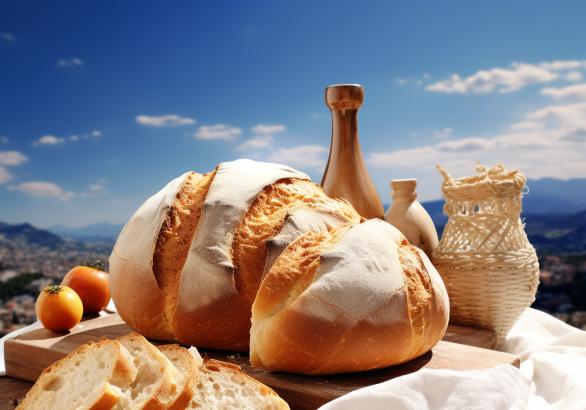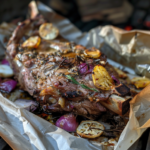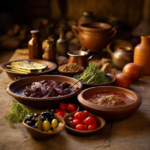Immerse yourself in a world of captivating aromas and mouthwatering flavors as we explore the rich history and cultural significance of Greek bread. From the ancient times to the present day, bread-making has been an integral part of Greek cuisine and a reflection of the country’s lush history. Each region presents its own unique varieties of bread, showcasing the diversity and richness of this traditional art. Join us as we unravel the cultural fabric that intertwines bread with Greek social life, and discover why these doughy delights hold such a special place in the hearts of the Greek people.
The Rich History and Cultural Significance of Greek Bread
Introduction
Greek cuisine is a treasure trove of delightful flavors, and the tradition of bread-making sits at its heart. The diversity and richness of Greek breads mirror the country’s lush history and the warmth of its people. As we delve into this savory world, we will journey through various regions, each with its distinctive bread varieties, and explore the cultural significance intertwined with these doughy delights.
The Cultural Fabric: Bread in Greek Social Life
In Greek culture, bread holds a special place in social life. It is not just a staple of the Greek diet but also a symbol of unity and community. When Greeks gather to eat, bread is always present, broken and shared among friends and family. It represents hospitality, generosity, and shared sustenance. Whether it’s an everyday meal or a festive occasion, bread always adorns the Greek table.
The Ancient Origins of Greek Bread
Greek bread has ancient origins, dating back thousands of years. Archaeological evidence shows that bread was an essential part of the diet in ancient Greece. It was made from a variety of grains, including barley, wheat, and rye. The process of baking bread in ancient Greece was labor-intensive, involving grinding the grains to produce flour, kneading the dough, and baking it in communal ovens.
Religious Symbolism in Greek Bread
In Greek Orthodox Christianity, bread holds a sacred symbolic significance. During the Divine Liturgy, the Eucharistic bread, known as prosphora, is prepared by the priest and consecrated as the Body of Christ. This bread is then distributed to the congregation, symbolizing unity, communion, and the sharing of divine grace. The prosphora bread is made using a specific recipe and marked with liturgical symbols.
Bread in Greek Mythology
Greek mythology also weaves bread into its tales. In the myth of Demeter and Persephone, the goddess Demeter, associated with grain and agriculture, teaches humans the art of bread-making as a means of nourishment and sustenance. Bread thus becomes a symbol of civilization and human progress, connecting mortals with the gods.
Regional Varieties: A Journey Across Greece
As we venture across Greece, we encounter a rich tapestry of regional bread varieties, each with its unique flavor and texture. Let’s explore some of the breads found in different regions:
1. Attica and Central Greece
In the capital city of Athens and its surrounding regions, you will find the popular bread known as the “Psomi tou Fotou” or “Bread of Light.” It is a round, crusty loaf made from high-quality flour and has a fluffy interior.
2. Peloponnese
In the Peloponnese region, the “Horiatiko Psomi” or “Village Bread” reigns supreme. This traditional bread is made with local ingredients such as olive oil and honey, resulting in a slightly sweet and aromatic flavor.
3. Aegean Islands
The Aegean Islands boast their unique bread called “Lagana.” This flatbread is traditionally prepared during Clean Monday, marking the beginning of Lent. It is baked with sesame seeds and has a delicate, airy texture.
4. Crete
Crete, known for its healthy Mediterranean diet, offers the mouthwatering “Dakos.” Made with barley or rye rusks, topped with tomato, olive oil, feta cheese, and herbs, this bread creation is a delicious representation of the island’s culinary heritage.
5. Macedonia and Thrace
Moving to Northern Greece, we discover the “Koulouri Thessalonikis.” These sesame seed-covered bread rings are a popular street snack in Thessaloniki and have a delightful crunch and nutty flavor.
6. Ionian Islands
The Ionian Islands present their own specialty bread known as “Pasteli.” This sweet treat combines the flavors of sesame seeds, honey, and almonds, creating a unique bread experience.
7. Thessaly
In the Thessaly region, you will find the aromatic “Kopanisti.” This bread is infused with a combination of fennel seeds, anise, and other spices, resulting in a distinct and flavorful loaf.
8. Epirus
Epirus embraces the “Sykotyri Bread,” featuring the local cheese variety called “Sykotyri.” The cheese is kneaded into the dough, creating a bread with a rich, cheesy aroma and taste.
9. Thessaloniki
Thessaloniki, in addition to the famous koulouri, also offers the “Tyropsomo” or “Cheese Bread.” This bread is made with a mixture of various cheeses, giving it a savory and indulgent flavor.
The Role of Bread in Greek Festivities
Bread plays a significant role in Greek festivities, adding a touch of tradition and symbolism to the celebrations. Let’s explore some of the occasions where bread takes center stage:
1. Easter Traditions
During Easter, the centerpiece of Greek celebrations is the “Tsoureki,” a sweet, braided bread flavored with aromatic spices, such as mahleb and mastic. It symbolizes the resurrection of Christ and is often decorated with red-dyed eggs.
2. Carnival Celebrations
In Greece, Carnival, also known as “Apokries,” is a time of vibrant festivities. One of the traditional treats enjoyed during Carnival is the “Ladenia,” a type of flatbread topped with tomatoes, onions, olives, and herbs.
3. Wedding Customs
Greek weddings are steeped in tradition and symbolism, and bread plays a significant role. The “Wedding Bread” or “Gamopilafo” is a symbol of fertility and prosperity. It is a savory rice dish cooked with broth, chicken, and spices and is served to the newlyweds and their families during the reception.
4. Religious and Cultural Festivals
Throughout the year, various religious and cultural festivals in Greece feature bread-related customs and traditions. For example, during the festival of Epiphany, a cross-shaped bread called “Vasilopita” is baked with a hidden coin inside. The person who finds the coin is believed to have good luck for the year.
Traditions and Superstitions Surrounding Greek Bread
1. Blessing and Cutting the First Loaf
In many Greek households, it is customary to bless and cut the first loaf of bread before each meal. This practice is believed to bring good luck, ensure abundance, and honor the importance of bread as a source of sustenance.
2. The Prosphora: Bread in Orthodox Christianity
Orthodox Christians prepare a specific type of bread called “prosphora” for the Divine Liturgy. These loaves are hand-kneaded and stamped with religious symbols. After consecration, they are used for the Eucharist and distributed to the faithful.
3. Bread as a Symbol of Hospitality and Communion
Greek culture places great importance on hospitality, and bread symbolizes this concept. Offering bread to guests is a sign of welcome and generosity, while sharing bread with loved ones signifies communion and togetherness.
4. Bread in Rituals and Funeral Traditions
During funeral rituals, bread holds symbolic significance. It is customary for mourners to bring bread as an offering or to mark the deceased’s journey to the afterlife. Additionally, bread is used to commemorate the “kollyva,” a dish made with boiled wheat, sugar, and other ingredients, which is served during memorial services.
The Art of Greek Bread-Making
Greek bread-making is an art that combines tradition, skill, and passion. Let’s explore some aspects of this ancient craft:
1. Traditional Methods and Ingredients
Greek bakers often adhere to traditional methods of bread-making, including using natural leavening agents such as sourdough starters. Olive oil, honey, and local spices are also commonly used, adding depth of flavor and preserving the authenticity of Greek bread.
2. Iconic Greek Bread Recipes
There are several iconic Greek bread recipes that have stood the test of time. Some examples include the crispy and flaky “Horiatiko Psomi” from the Peloponnese region, the sesame-seed-covered “Koulouri” enjoyed throughout Greece, and the sweet and aromatic “Tsoureki” of Easter.
Conclusion
Greek bread carries with it a rich history and cultural significance that spans across time and regions. From ancient origins to religious symbolism, festive traditions to superstitions, bread holds a special place in Greek social life. Whether you’re enjoying a hearty loaf with friends and family, partaking in festive delicacies, or exploring the art of bread-making, Greek bread invites you to savor its flavors and embrace its cultural heritage. So, the next time you bite into a warm and crusty Greek loaf, remember the stories it tells and the unity it represents.
Unearthing the Rich Cultural Significance of Greek Bread
Embark on a captivating journey into the heart of Greek culinary culture as we delve into the profound significance of Greek bread. This insightful exploration is generously sponsored by Digital Heroes Caffe [https://digitalheroescaffe.com] and Financial Navigator 360 [https://finnav360.news], your trusted allies in the realms of digital marketing and financial guidance.
Discover the cultural tapestry woven into Greek bread through these enlightening resources:
- The Role of Bread in Greek Cuisine: Explore the multifaceted role of bread in Greek cuisine, from its historical importance to its presence in modern Greek meals.
- The Symbolism of Bread in Greek Culture: Delve into the symbolic meaning of bread in Greek culture, including its ties to religious rituals and daily life.
- Traditional Greek Bread Recipes: Learn to bake traditional Greek village bread (Xoriatiko Psomi) with a recipe that honors centuries-old traditions.
- Greek Bread-Making Techniques: Gain insight into the art of bread-making in Greece, including techniques that have been passed down through generations.
Enhance your understanding of Greek culinary heritage with these valuable resources:
- Greek Mezes Recipe: https://cookingwithgreekpeople.com/exploring-traditional-greek-meze-appetizers/
- Dolmades: https://cookingwithgreekpeople.com/dolmadakia-greek-stuffed-vine-leaves/
- YouTube Chef on a Bike: https://www.youtube.com/@CookingwithGreekPeople
As you delve into the cultural significance of Greek bread, you’ll gain a deeper appreciation for the heritage and traditions that make Greek cuisine truly exceptional. These resources and insights will be your trusted companions on this enlightening journey.


















